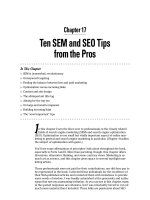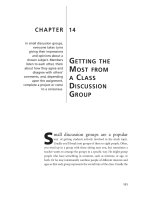INTERDEPENDENCE AND THE GAINS FROM TRADE group MC
Bạn đang xem bản rút gọn của tài liệu. Xem và tải ngay bản đầy đủ của tài liệu tại đây (3.58 MB, 28 trang )
Ho Chi Minh University of Foreign Languages and
Information Technology
INTERDEPENDENCE AND
THE GAINS FROM TRADE
Group MC:
Nguyen Le Anh Dao
Do Hoang Hai Anh
Ta Ngoc Quynh Nhu
Vu Thi Ngoc Phuong
Nguyen Vu Hai Thao
Nguyen Thi My Ngan
Vo Thi Kim Hang
Duong Hoang An
Pham Thanh Thao
Ly Phong
Content
Problem 1: The Parable for the modern economy
Production possibilities
Specialization and Trade
Problem 2: Comparative Advantage: The Driving Force of
Specialization
Absolute advantage
Opportunity cost and Comparative Advantage
Comparative advantage and Trade
The Price of the Trade
Problem 3: Applications of Comparative Advantage
Should Tom Brandy Mow His Own Lawn?
Should the United States Trade with other Country?
Problem 1:
The Parable for the modern
economy
Production possibilities:
Specialization and Trade
What is Specialization?
Specialization is a method of production where a business , area or
economy focuses on the production of a limited scope of products
or services to gain greater degrees of productive efficiency within
an overall system.
THE RELATIONSHIP BETWEEN
SPECIALIZATION AND TRADE
Specialization refers to the tendency of countries
to specialize in certain products which they trade
for other goods, rather than producing all
consumption goods on their own. Countries
produce a surplus of the product in which they
specialize and trade it for a different surplus good
of another country. The traders decide on whether
they should export or import goods depending on
comparative advantages.
Problem 2:
Comparative Advantage: The
Driving Force of Specialization
Absolute advantage
THEORY OF ABSOLUTE ADVANTAGE
Developed by Adam Smith.
Under free and unregulated trade, a nation should
specialize in producing those goods it could
produce most efficiently (had an absolute
advantage, either natural or acquired).
The capability of a nation to produce more of a
good with the same amount of input than another
country.
What is Smith’s theory of
Absolute Advantage?
Adam Smith argued that
a country has an
absolute advantage in
the production of a
product when it is more
efficient than any other
country in producing it.
→ Countries should specialize in the production of goods for which
they have an absolute advantage and they trade these goods for
the goods produced by other countries.
.
Example: Assume that
there are only two
countries - Country A and
Country B - producing only
two goods, corn cereal and
designer jeans. The table
here shows the production
possibilities for these two
countries. Which of the
following statements is
=>
Country A has an absolute advantage in
correct?
the production of both goods.
OPPORTUNITY COST AND
COMPARATIVE ADVANTAGE
Opportunity cost
Whatever must be given up to obtain some
item
Comparative advantage
The ability to produce a good at a lower
opportunity cost than another producer
In our example, we assumed that the
farmer and the rancher each spend 8
hours a day working
Time spent producing potatoes,
therefore, takes away from time
available for producing meat
The rancher and farmer give up units of
one good to produce units of the other
The opportunity cost measures the
trade-off between the two goods that
each producer faces
The opportunity cost of meat is the
inverse of the opportunity cost of
potatoes
Economist use the term comparative
advantage when describing the
opportunity cost of two producers
The producers who gives up less of
other goods to produce good X has the
smaller opportunity cost of
producing good X and is said to have a
comparative advantage in producing
it
An ounce of potatoes costs the
farmer only ¼ ounce of meat, but it
costs the rancher ½ ounce of
meat
The rancher has a lower
opportunity cost of producing meat
than the farmer
The farmer has a comparative
advantage in growing potatoes, and
the rancher has a comparative
Comparative advantage reflects
the relative opportunity cost
Unless two people have exactly
the sam opportunity cost, one
person will have a comparative
advantage in one good, and the
other person will have a
comparative advantage in the
other good
Comparative Advantage:
The Driving Force of
Specialization
Comparative Advantage and Trade
The gains from specialization and
trade are based not on absolute
advantage but on comparative
advantage.
When each person specializes in
producing the good for which he or she
has a comparative advantage, total
What is comparative advantage?
An economic law referring to the ability of any
given economic actor to produce goods and
service at a lower opportunity cost than other
economic actors.
Ex: two countries
producing only two
goods - motor cars
and commercial
trucks.
Country A can produce
30m cars or 6m trucks,
and country B can
produce 35m cars or 21m
trucks.
country B has the
absolute advantage in
producing both products
it has a comparative
advantage in trucks
because it is relatively
better at producing them.
Country B is 3.5 times
better at trucks, and only
Problem 3:
Applications of Comparative Advantage
Should Tom Brandy Mow His Own Lawn?
The principle of comparative advantage
explains interdependence and the gains
from trade.
Opportunity cost of the item is what we give
up to get the item.
What does Tom do with 2 hours?
Mow his own lawns.
Film the TV show and get
$20,000.
What does Gump do with 4 hours ?
Mow Tom’s lawns.
Work at McDonald and get $40.
Tom has absolute advantage in mowing
his own lawns because he takes lower
time than Gump (2hrs < 4hrs).
Gump has a comparative advantage in
moving lawns because his opportunity
costs is only $40 but Tom is $20,000.
The better for both of them is Tom films the TV
show and hires Gump to mow his lawns.
Should the United States Trade with other Country?
More than 41 million American jobs depend on
trade
Manufacturing is the sector that exports the
most, with more than $1.4 trillion worth of
exports in 2014
The U.S. Department of Commerce estimates
that exports of manufactured goods directly
support approximately 6 million U.S. factory









